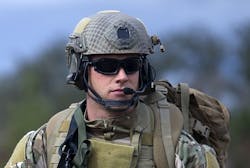Army researchers reach out to industry for ideas on next-generation Special Forces radio headsets
NATICK, Mass., 4 March 2014. U.S. Army researchers are looking into new technologies for next-generation tactical communications headsets and push-to-talk (PTT) controls for Special Operations warfighters, and are asking industry experts for their best ideas.
Officials of the Army Contracting Command in Natick, Mass., have issued a sources-sought notice (SOF0005) for next-generation Special Forces radio communications headsets and PTT controls.
The notice was issued on behalf of the 724 Special Tactics Squadron (STS) and the Project Manager Special Operations Forces Survival, Support and Equipment Systems. These authorities are asking industry their capabilities to produce and supply a next-generation headset suite.
Researchers are interested in next-generation tactical communications headsets with these capabilities:
Related: 3M Peltor COMTAC III ACH supports critical communications, helps preserve hearing
-- monophonic audio of two communications networks simultaneously and independently in each ear, with no bleedover or crosstalk issues;
-- compatible and functional with Special Forces ballistic helmet, protective eyewear, armor, load carriage system, and other protective equipment in common mission configuration;
-- operated by right or left handed operator, with or without gloves;
-- compatible and functional with all current Special Forces radio communications equipment;
-- ability for operators to listen and talk clearly in low and high noise environments;
-- hearing protection from steady-state and impulse noise;
Related: Prosthetics meet robotics
-- no hindrance to a wearer from hearing enemy gunfire and determining its position;
-- ability to amplify ambient sounds;
-- ability to monitor and selectively transmit on two or three radio communications networks;
-- mission capable after constant contact with salt water and perspiration for 24 hours, as well as immersion in three feet sea water for 30 minutes, without additional preparation or cleaning;
-- meet or exceed IP66 and IP67;
-- protection from sand, salt, sea spray, heavy rain, with zero water intrusion into sealed components;
-- cables able to disconnect and reconnect while exposed to maritime conditions on the surface;
Related: Air Force asks industry for hand-held Link-16 special operations networking radios
-- mission capable after dynamic immersion in three feet of sea water for four hours and require no additional preparation or cleaning;
-- cables the user can disconnect and reconnect while submerged;
-- ability to operate for 12 hours per day during a five-day mission without spares or logistical support;
-- no adverse limitations to the operator's range of motion in his ability to shoot, move, or communicate while wearing a helmet, equipment, and body armor;
-- cables and connectors that can disconnect and reconnect in three seconds or less in total darkness;
-- normal operation of the push-to-talk for at least 36 hours without replacing or charging batteries;
-- power source shall provide 250 hours of operation before recharging or replacing;
-- non-proprietary power source that is field replaceable without special tools in less than one minute;
-- discreet power availability indicator;
-- headset that can receive and transmit with or without external power source;
-- push-to-talk that works for at least 56 hours without replacing or charging batteries;
-- active noise isolation and the ability to distinguish between direct conversation and background conversations and noises;
-- ability to distinguish between direct conversation and background conversations and noises; and
-- active noise reduction.
Companies interested should email their ideas to the Scott Germain at [email protected] no later than 10 March 2014.
More information is online at https://www.fbo.gov/notices/2d5ed5d416fe125222b1135ed3617c52.

